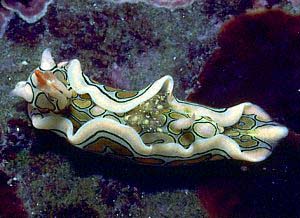
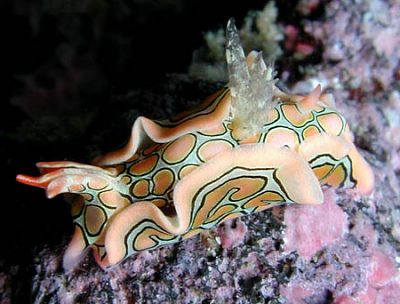
Sagaminopteron psychedelicum
Carlson & Hoff, 1974
Order: CEPHALASPIDEA
Family: Gastropteridae
DISTRIBUTION
Originally described from Guam, this animal is now known from many parts of the tropical western Pacific.
PHOTO
UPPER: Coffs Harbour region, New South Wales, Australia, December 1990. Grows to about 12mm long. PHOTO: Bill Rudman.
LOWER: Hachijo Is. Tokyo, Japan., 8 June 2002,
Depth: 6m., Length: 8mm. Photo: C. Nishina
Given its name for its bright and colourful colour pattern, this species is not as spectacular a swimmer as Sagaminopteron ornatum
Reference:
• Carlson, C.H. & Hoff, P.J. (1974) The Gastropteridae of Guam, with descriptions of four new species (Opisthobranchia: Cephalaspidea). Publications of the Seto Marine Biological Laboratory, 21(5/6): 345-363.
Rudman, W.B., 1998 (December 18) Sagaminopteron psychedelicum Carlson & Hoff, 1974. [In] Sea Slug Forum. Australian Museum, Sydney. Available from http://www.seaslugforum.net/find/sagapsyc
Related messages
Sagaminopteron psychedelicum from Saipan, nthn Mariana Islands
January 13, 2010
From: Yuji Fujie
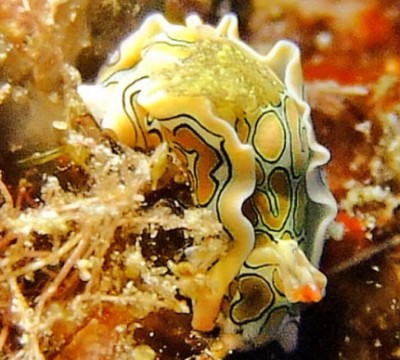
Concerning message #17122:
Dear Dr.Bill,
This animal was on a black sponge for a long time. It seemed to be feeding. However, I am not sure that the animal was actually eating the sponge.
Locality: Grotto, 12m, Saipan, Northern Mariana Islands, Pacific Ocean, 09 December 2009, On black sponge. Length: 6 mm. Photographer: Yuji Fujie.
I have found Sagaminopteron psychedelicum several times recently although it is not usually common in this area.
For instance, it saw on the Tinian island and the Goat island in November.
Best regards,
Yuji
scuba.element@gmail.com
Yuji Fujie, 2010 (Jan 13) Sagaminopteron psychedelicum from Saipan, nthn Mariana Islands. [Message in] Sea Slug Forum. Australian Museum, Sydney. Available from http://www.seaslugforum.net/find/23095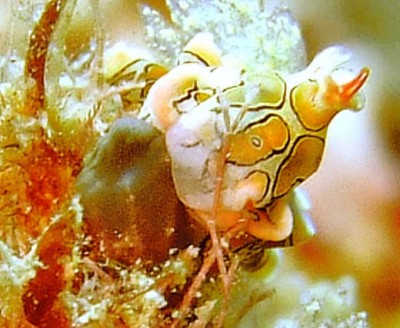
Dear Yuji,
Thanks for the record. As I discussed in the message you refer to, gastropterids are often found on sponges, but I suspect they don't feed on them. Perhaps 2010 will be the year we discover just what they eat
Best wishes,
Bill Rudman
Sagaminopteron psychedelicum found sthrn Queensland
April 7, 2008
From: Gary Cobb
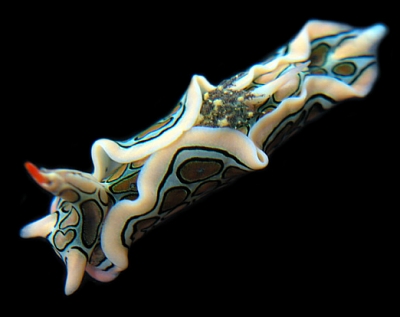
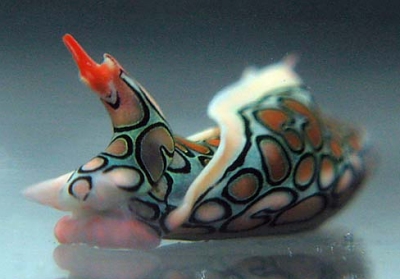
Hi Bill and everyone!
Please find here records of Sagaminopteron psychedelicum found here on the Sunshine Coast at Old Woman Island and the Gneerings.
Locality: Mooloolaba, Sunshine Coast, 10-15 m, Queensland, Australia, Pacific Ocean, 02 December 2006, Subtidal. Length: 15 mm. Photographer: Gary Cobb.
This animal rates as one of the most beautiful. It has been found a half a dozen times here.
Cheers
Gary Cobb
gary@nudibranch.com.au
Cobb, G.C., 2008 (Apr 7) Sagaminopteron psychedelicum found sthrn Queensland. [Message in] Sea Slug Forum. Australian Museum, Sydney. Available from http://www.seaslugforum.net/find/20938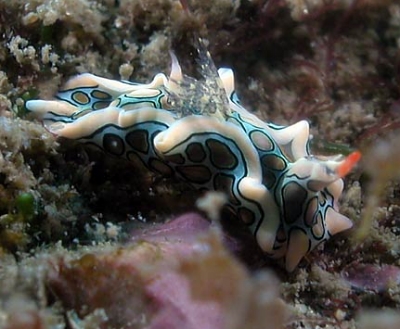
Dear Gary,
This 'child' of the 1970s was very appropriately named
Best wishes,
Bill Rudman
Sagaminopteron psychedelicum from Malaysia
July 14, 2006
From: Asther M. Lau
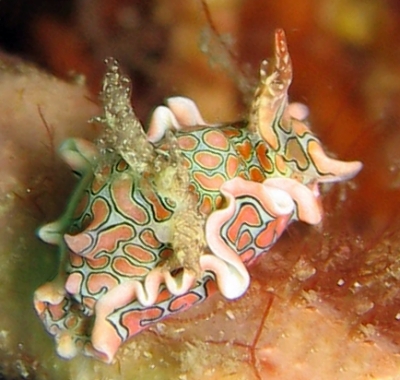
Dear Bill,
I believe this is a Sagaminopteron psychedelicum. Just to share with the forum.
Locality: Tenggol Island, 10 meters, Terengganu, Malaysia, South China Sea, 23 July 2004, Coral reef with sponges & soft coral collection. Length: About 1 cm. Photographer: Asther M. Lau.
Regards,
Asther
asther@astherlau.com
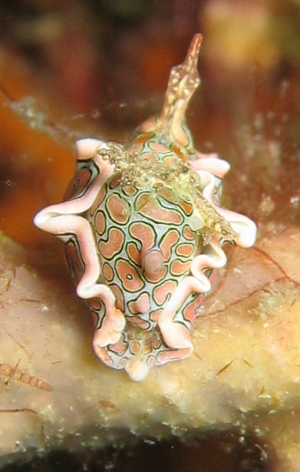
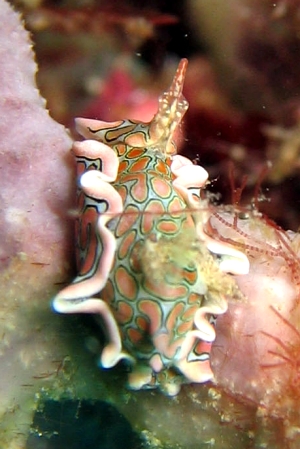
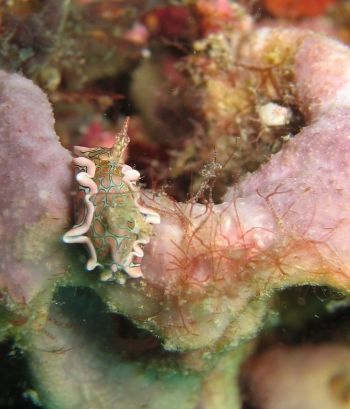
Dear Asther,
Thanks for these photos of Sagaminopteron psychedelicum. The presence of this animal on an irciniid-like sponge reminds me of an earlier correspondence on the Forum [message #3767] which has led to pretty conclusive evidence that all species of Trapania, which are often found clustered on similar sponges, eat not the sponges but small entoprocts which themselves live in association with the sponges. Many gastropterids are also found on sponges but I am sure they do not feed on them. Gastropterids are related to aglajids and philinids, so we would expect them to feed on small free-living invertebrates such as flat worms, polychaete worms or something similar. One day - hopefully not too far in the future - some keen-eyed observer will find one eating something.
Best wishes,
Bill Rudman
Another Sagaminopteron psychedelicum picture
March 18, 2005
From: Oren Lederman
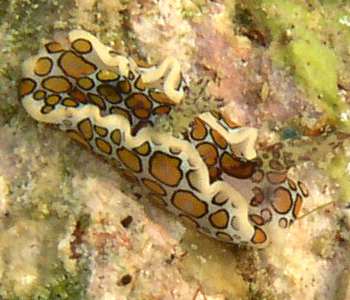
Hi Bill,
Here's another Sagaminopteron psychedelicum we found last year.
Locality: "Dekel" beach, Eilat bay, Israel, Red Sea. Depth: ~22 m. Length: ~1 cm. 16 Sep 2004. corals. Photographer: Oren Lederman
Oren
lederman@bigmail.co.il
Lederman, O., 2005 (Mar 18) Another Sagaminopteron psychedelicum picture. [Message in] Sea Slug Forum. Australian Museum, Sydney. Available from http://www.seaslugforum.net/find/13355Thanks Oren,
Best wishes,
Bill Rudman
Sagaminopteron psychedelicum from the Red Sea
March 16, 2005
From: Oren Lederman
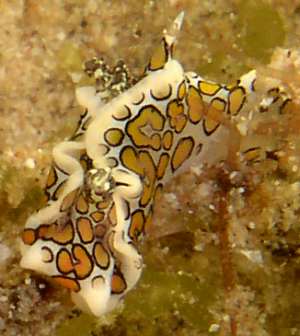

Hi Bill,
Here is a Sagaminopteron psychedelicum from last weekend.
Locality: Princess Beach, Eilat Bay, Israel, Red Sea. Depth: 20 meters. Length: ~ 1 cm. 11 Mar 2005. sea grass. Photographer: Oren Lederman
Oren Lederman
lederman@bigmail.co.il
Lederman, O., 2005 (Mar 16) Sagaminopteron psychedelicum from the Red Sea. [Message in] Sea Slug Forum. Australian Museum, Sydney. Available from http://www.seaslugforum.net/find/13334Thanks Oren,
There are very few records of this species from the Indian Ocean. The only ones I can think of are Nathalie Yonow's (2000) photographic record from Jeddah, Saudi Arabia, Red Sea, and a couple of messages on the Forum from Reunion Island.
-
Yonow, N. (2000) Red Sea Opisthobranchia 4: The orders Cephalaspidea, Anaspidea, Notaspidea and Nudibranchia: Dendronotacea and Aeolidacea. Fauna of Arabia, 18: 87-131.
Best wishes,
Bill Rudman
Sagaminopteron psychedelicum from Reunion Island
February 14, 2005
From: Philibert Bidgrain
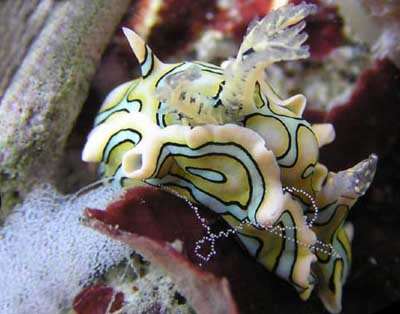
Dear Bill,
Reunion Island sea slugs.
Sagaminopteron psychedelicum is relatively common in "Etang sale lagoon" from September to January where we can observe it under rocks. I continue to observe its presence in that site all year. We have only one photo from a diving site on the reef. I photographed this specimen laying its eggs but looking at the photo, there seems to be a second animal behind the first.
Locality: Etang Salé les bains" lagoon, Reunion Island, Indian ocean. Depth: 50 cm. Length: 10 to 15 mm. 25 September 2005. Photographer: Philibert Bidgrain
Best Regards
Philibert Bidgrain
http://vieoceane.free.fr/runseaslug/indexslug.htm
pbidgrain@yahoo.fr
Bidgrain, P., 2005 (Feb 14) Sagaminopteron psychedelicum from Reunion Island. [Message in] Sea Slug Forum. Australian Museum, Sydney. Available from http://www.seaslugforum.net/find/13098Dear Philibert,
I think there is only one animal there. Its head is at the lower right of the photo. Your photo shows the gills very well
Best wishes,
Bill Rudman
Sagaminopteron psychedelicum from Reunion
February 10, 2004
From: Olivier Aubrespin
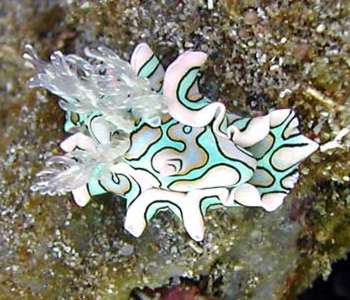
Hello,
I found this little animal in the lagoon of St Pierre, Réunion Island (Mascaregnas), Depth 1 m in May 2003. Length approx 1-2 cm.
Can you help me identify it?
Olivier Aubrespin
olivier.aubrespin@wanadoo.fr
Aubrespin, O., 2004 (Feb 10) Sagaminopteron psychedelicum from Reunion. [Message in] Sea Slug Forum. Australian Museum, Sydney. Available from http://www.seaslugforum.net/find/12164Dear Olivier,
This does look like a nudibranch with its bright colours and large branched gills, but it is in fact a type of bubble shell [Cephalaspidea] called Sagaminopteron psychedelicum, its name coming from its crazy psychedelic colour pattern.
Gosliner 1989 mentions that Dr Maurice Jay observed this species at Reunion, but as far as I know that is the only other record of it from the Indian Ocean. An interesting find
Best wishes
Bill Rudman
Juvenile Sagaminopteron psychedelicum
January 11, 2003
From: C. Carlson & P. J. Hoff
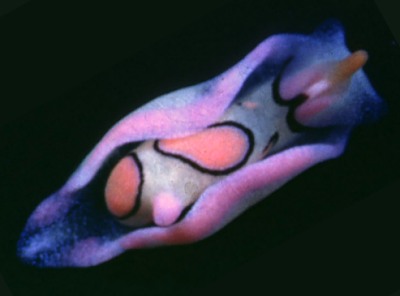
Bill,
Here is a youngster for the season - a very small Sagaminopteron psychedelicum 2.5mm; Guam, Bile Bay, reef flat; 2 January 1972.
Have a good holiday season!
Clay & Patty Jo
Thanks Clay & Patty Jo,
Even at this size, this not much doubt about who its mother and father were.
Best wishes,
Bill Rudman
Sagaminopteron psychedelicum from Hachijo
August 16, 2002
From: Nishina Masayoshi

Dear Bill,
Sagaminopteron psychedelicum is rather rare at Hachijo island. K. Tanaka who is always guiding us there told me that the black spot in the lower right image, is the eye (red arrow).
Date: 8 June 2002
Location: Hachijo Is. Tokyo, Japan.
Lengh: 8mm
Depth: 6m
Water temp: 20C degree
Photo: C. Nishina
Best Regards,
Nishina Masayoshi
nishina@wips.co.jp
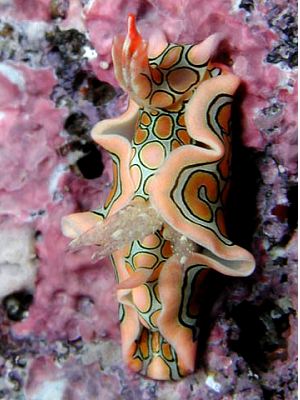
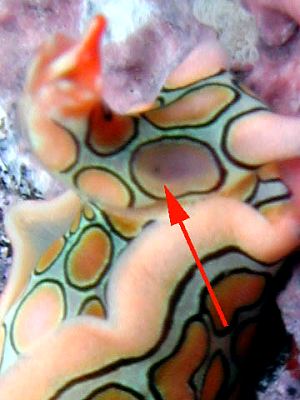
Dear Nishina & Chikako,
Thanks for these wonderful photos. Yes the black spot is the eye. In most sea slugs the eyes are difficult to see because they are are beneath the skin on the inside edge of the body wall. Quite a few species, like Sagaminopteron psychedelicum, have a semitransparent or translucent patch above each of the eyes so some light can get through. This is particularly noticeable in species with a very opaque pigment. A good example is Tambja abdere.
Best wishes,
Bill Rudman
Sagaminopteron psychedelicum from Taiwan
January 23, 2002
From: Bernard Picton
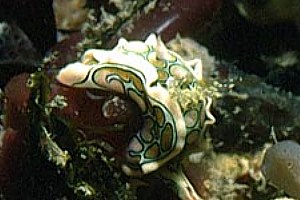
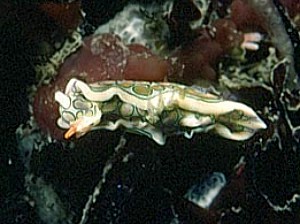
Hi Bill,
Here are two photographs showing Sagaminopteron psychedelicum from Taiwan, March 1983. This is an enlargement of a photo I sent earlier of Chromodoris orientalis. I think both the chromodorid and Sagaminopteron psychedelicum may both be feeding on the dull red sponge which they are sitting on. If I had to guess I'd say it looked like an Oscarella species
(which have no spicules).
Bernard
bernard.picton.um@nics.gov.uk
Picton, B., 2002 (Jan 23) Sagaminopteron psychedelicum from Taiwan. [Message in] Sea Slug Forum. Australian Museum, Sydney. Available from http://www.seaslugforum.net/find/5958Thanks Bernard,
Perhaps 2002 could be the year that someone presents us with good evidence of just what gastropterids feed on. To me, the shape of their teeth makes it quite unlikely that they feed on sponges, and if they do, why haven't they been found in the act of feeding? I know that they are often found on sponges, but so are species of Trapania and from your observations we know know that they feed on entoprocts which live on sponges.
Best wishes,
Bill Rudman
